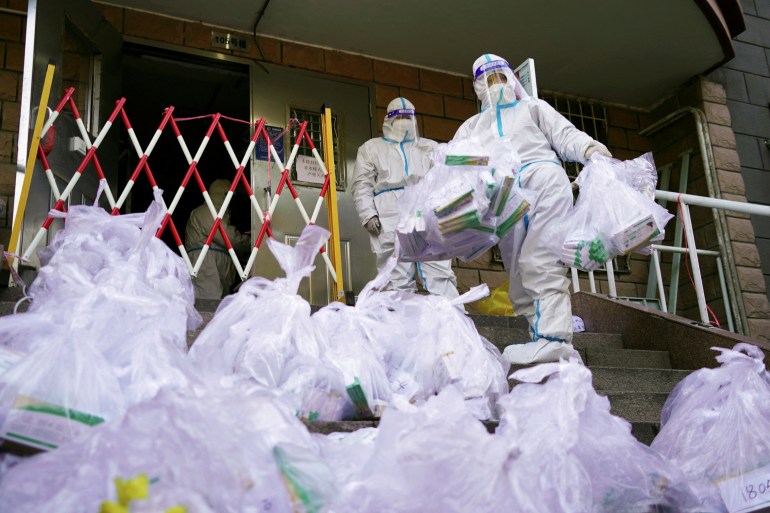November 22 2022
China: Near-Record Number Of ..Covid Infections
- In the last few days, the mainland China daily Covid case count has climbed to around or more than 28,000 — near levels seen in April during a stringent lockdown in Shanghai, according to CNBC calculations of Wind Information data.
- “China might have already passed the point of no return, as it's unlikely to achieve zero Covid again without another Shanghai-style hard lockdown," Macquarie's Chief China Economist Larry Hu said in a report Tuesday.
- In GDP terms, nearly 20% of China's economy was negatively affected by Covid controls as of Monday, close to the high of 21.2% recorded in mid-April during Shanghai's lockdown, Nomura's Chief China Economist Ting Lu said, citing the firm's model.
BEIJING — Surging Covid infections across mainland China make it harder for the government to achieve zero-Covid without reverting to a harsh lockdown, Macquarie's Chief China Economist Larry Hu said.
In the last few days, the daily case count has climbed to around or more than 28,000 — near levels seen in April during a stringent lockdown in Shanghai, according to CNBC calculations of Wind Information data. The figures showed the last time mainland China saw only a handful of daily infections was in June, shortly after Shanghai eased its restrictions.
The latest Covid wave has hit the southern city of Guangzhou, the capital city of Beijing and many central parts of China — prompting local officials to tighten restrictions on business and social activity this month.
“China might have already passed the point of no return, as it's unlikely to achieve zero Covid again without another Shanghai-style hard lockdown," Hu said in a report Tuesday. "What policymakers could do now is to slow the spread of virus, i.e. flatten the curve, by tightening the Covid controls for the time being."
Hu pointed to slight changes this month in government policy and propaganda as signs authorities are preparing for reopening in the next six to nine months. But he noted that "the road to reopening is set to involve lots of back-and-forth."
Markets have speculated for weeks about the timing of China's departure from its stringent zero-Covid policy. The controls have weighed on the economy, which barely eked out growth while Shanghai was locked down and has posted growth of only 3% during the first three quarters of the year.
In GDP terms, nearly 20% of China's economy was negatively affected by Covid controls as of Monday, close to the high of 21.2% recorded in mid-April during Shanghai's lockdown, Nomura's Chief China Economist Ting Lu said, citing the firm's model.
"Beijing has recently shown early signs of willingness to reopen, and it has rolled out some fine-tuning measures, but the reopening may be a prolonged process with discomfort," Lu said in a separate report this week.
He said Vietnam's unwinding of its Covid restrictions since fall last year could shed light on the path forward for China. He noted how the Southeast Asian country saw "no immediate surge in infections after the pivot," while its GDP rebounded.
Covid controls tighten in Beijing
Local authorities in China have faced the difficult task of trying to make Covid measures more targeted, while controlling infections.
As of Monday, about 412 million people were affected by lockdown measures in mainland China, according to Nomura estimates. That's up from 340 million the prior week, the report said.
The Nomura analysts noted that many lockdowns or controls are implemented without public announcement. "We believe [the southwestern municipality of] Chongqing is currently experiencing the most severe local lockdown in China, based on our observation of numerous mobility metrics," the report said.
Covid controls in Beijing alone have tightened since Tuesday.
Authorities announced requirements for more frequent virus testing, and ordered more restaurants to suspend in-store dining. More shopping malls have closed, as have large parks. Various apartment compounds have been locked down.
State media said Tuesday the city's tech-focused Zhongguancun Forum that was scheduled to kick off this week will be postponed to next year. The conference had already been delayed from September.
Chinese authorities are introducing new restrictions across the country as infections look set to pass April’s peak.

China's sputtering economic recovery is facing new challenges as authorities roll out new COVID restrictions across the country
Taipei, Taiwan – China’s COVID-19 cases are surging toward record highs, signalling more pain for the world’s second-largest economy as hopes fade for a quick exit from Beijing’s draconian “zero-COVID” policies.
The National Health Commission on Wednesday reported 29,157 infections nationwide for the previous day, close to April’s peak.
China’s daily caseload peaked at 29,411 on April 13, when Shanghai was several weeks into a punishing lockdown that prompted food shortages and rare displays of social unrest.
The rising cases come as a video circulating on social media on Wednesday appeared to show fresh worker unrest at Apple supplier Foxconn’s massive manufacturing facility in the industrial city of Zhengzhou.
In the footage shared on video platform Kuaishou, people could be seen smashing surveillance cameras and windows, pulling down barriers and arguing with hazmat-suited officials while chanting for their pay.
Numerous former Foxconn workers have complained of food shortages and draconian quarantine rules at the campus, which is home to the world’s largest iPhone factory. The Reuters news agency reported that two sources with knowledge of the matter confirmed protests at the Zhengzhou facility but declined to provide further details.
More than half of Wednesday’s caseload, which includes more than 26,400 infections classed as asymptomatic, were reported in Guangzhou and Chongqing, mega-cities in southern and central China, respectively, that are home to more than 35 million people.
In Beijing, where authorities have shuttered schools, strengthened testing requirements, and restricted movements in and out of the city, infections hit a new peak of 1,486.
Shanghai and Zhengzhou, both of which are battling smaller outbreaks, also saw their cases rise from the previous day.
Guangzhou began a five-day lockdown on Monday, following similar measures earlier this month that led to rare public protests, while the southwestern city of Chengdu on Wednesday began a new round of mass testing.
The restrictions are a new blow to China’s sputtering economic recovery and pour cold water on expectations of a shift away from “zero COVID” after the announcement of separate plans to ease restrictions and revive the ailing real estate sector briefly generated positive buzz on Wall Street.

“My sense is that [the optimism] is going to be short-lived because the market has struggled. The October data was literally horrible but because they had these two big announcements, they could not just bypass them,” Alicia Garcia-Herrero, the chief economist for Asia Pacific at financial services firm Natixis, told Al Jazeera, referring to the economic plans.

“However, November is going to be equally horrible because the opening up has not happened.”
China’s economy is expected to struggle to reach 3 percent growth in 2022, which would be one of its weakest showings in decades. Gross domestic product (GDP) officially grew 3.9 percent during the July-September period, after expanding just 0.4 percent in the second quarter.
Garcia-Herrero said one key indicator to watch is mobility, which has remained low across all of China’s main cities except for Shanghai, driving down consumer spending and investment. Export growth was also negative in October, declining 0.3 percent year-on-year, for the first time since June 2020 due to COVID-19 restrictions as well failing demand outside China, according to Natixis.
China is now in something of a Catch-22, said Garcia-Herrero, as its economic recovery requires increased mobility, but loosening restrictions will lead to a surge in deaths, particularly among the elderly.
The country has struggled to vaccinate its elderly population, with only 66 percent of people aged 80 and above inoculated, among whom just 40 percent have received a booster shot.
China’s domestic Sinovac vaccine has also been shown in studies to be less effective at preventing severe disease than its mRNA counterparts.
Even if China can boost its vaccination rate and make the transition to living with the virus, exiting “zero COVID” will not solve China’s economic woes overnight, said Carsten Holz, an economist at the Hong Kong University of Science and Technology, who described the harsh strategy as “double whammy for the economy.”
“As long as COVID-19 restrictions are in place, they hamper output, create supply chain disruptions, and disrupt retail sales,” Holz told Al Jazeera. “When COVID restrictions are finally lifted, the economy goes through several adjustment cycles, leading to yet more disruptions and instability. In the meantime, some foreign demand may also permanently have left the PRC [People’s Republic of China].”
‘Coexistence with the virus’
China’s modest economic rebound in the third quarter also does not offer much hope of a strong finish to the year, according to economists.
Much of the country’s recent growth has been driven by the state sector and not private consumption, said Nick Marro, the lead analyst for global trade at the Economist Intelligence Unit, as confidence among foreign and private firms on the ground remains “shattered” thanks to “zero COVID.”
“When we think about where growth is coming from, the economy is increasingly imbalanced,” Marro told Al Jazeera. “If you look over the last two years, a lot of the growth has been coming from investments and exports and it hasn’t really been coming from private consumption because ‘zero COVID’ has just decimated retail activity and just decimated private consumption.”
Notably, Chinese e-commerce giant Alibaba, which has seen its revenue growth flatline in recent months, this month did not disclose the sales figures for its November 11 “single’s day” shopping holiday – an event that saw $84.5bn in sales in 2021.
Apple supplier Foxconn has also struggled to produce the iPhone 14 Pro and Pro Max at its enormous Zhengzhou factory following a spike in infections that forced the company to shutter its factory earlier this month.
Marro said the factory closure showed the limits of “zero COVID” even as companies try to diversify production sites – but also how far Beijing has to go to convince people to live with the virus.
“What’s … interesting is we saw an exodus of people leaving Zhengzhou, and there was some discussion that conditions in the dorms were so bad because of ‘zero COVID,’ but it also seemed like people were fleeing because they were literally terrified of catching the virus,” he said.
“I think that’s a great illustration of the fact that the government hasn’t done anything that shows COVID isn’t as scary as it used to be. Even if the government wants to lift COVID zero protocols, the population itself might still be very, very hesitant on accepting that and themselves moving towards this coexistence with the virus.”



 The Weather Network
The Weather Network



No comments:
Post a Comment
Comments always welcome!